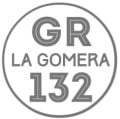Over the past few years, we have received numerous questions about the circular hike and La Gomera in general. We have summarized the most important of them as an FAQ for you.
Various travel reports, variants or abbreviations can be found under testimonials. There you also have the opportunity to get rid of new questions.
Due to the stable climate, La Gomera is actually suitable for a holiday all year round.
The average daily high temperatures vary between
- 21 degrees in winter,
- 23-25 degrees in spring/autumn and
- 28-29 degrees in midsummer.
Regardless of the season, good sun protection (sunscreen, hat) is essential, as the circular hike on La Gomera is rarely in the shade.
At the same time, it can sometimes be foggy and significantly colder, especially on the north side of the island and at higher altitudes. This must be taken into account when choosing hiking clothing: eg a functional fleece jacket in addition to a hiking T-shirt. In addition, it may make sense to have a small umbrella with you, especially in the winter months.
However, whether you want to do the quite strenuous circular hike in July or August, everyone should decide for themselves. Then the temperatures are at their highest, but at the same time there is also a kind of good weather guarantee: according to the climate table, "an average of 0 rainy days in July and August" :-)
In summary: Hiking on La Gomera is definitely recommended from mid-September to mid-June, in midsummer only for those who have no problem with slightly higher temperatures.
Prices:
On the subject of “accommodation prices”, my observation is that prices are quite stable and relatively low all year round. Only those who want to hike between Christmas and New Year or around Easter must expect slightly higher prices and reserve accordingly in good time.
Therefore, hiking boots are essential for good surefootedness and protection against twisting. Telescopic hiking poles are also almost mandatory on this tour - the long descents in particular put an unnecessarily heavy strain on the knees with a full pack.
- the route is physically demanding, but technically easy to master (no climbing necessary)
- There are only a few dead spots, the network coverage for mobile phones on La Gomera is almost always good enough, for example for emergency calls
- In the course of (almost) every stage you come across towns or roads several times - so you are rarely completely cut off from civilization for the whole day. Exception: Stage 6 is really quite lonely!
Here is an overview of places I know of where to shop:
| Stage: | Shops / water supply in: |
| Stage 1: San Sebastián de la Gomera – La Calera | Start: Supermarkets in San Sebastián de la Gomera Middle: small shop and bar/restaurant in Chipude Destination: small shop and bars in La Calera |
| Stage 2: La Calera – Las Hayas | Start: small shop and bars in La Calera Middle: restaurants/bars in Aruré Destination: Bar/Restaurant in Las Hayas |
| Stage 3: Las Hayas - Vallehermoso | Start: Bar/Restaurant in Las Hayas Center: Restaurants/bars in Aruré and Alojera, Restaurant "Chorros de Epina" above Epina where the GR-132 meets the island's main road Destination: large supermarket etc. in Vallehermoso |
| Stage 4: Vallehermoso - Hermigua | Start: large supermarket etc. in Vallehermoso Middle: Restaurant "El Campesino" in Las Rosas, several restaurants at "Juego de Bolas", restaurants/bars in Agulo Destination: large supermarket etc. in Hermigua |
| Stage 5: Hermigua – San Sebastián de la Gomera | Start: large supermarket etc. in Hermigua Middle: – Destination: Supermarkets in San Sebastián de la Gomera. One hour before San Sebastián “Bar El Atajo” |
| Stage 6: San Sebastián de la Gomera – Playa de Santiago | Start: Supermarkets in San Sebastián de la Gomera Center: - (the hotel complex on the beach "El Cabrito" operates the restaurant only for hotel guests, but water may be sold) Destination: Supermarkets in Playa de Santiago |
| further course of the GR-132 between Playa de Santiago and La Calera | We do not have any information on the “Playa de Santiago – La Calera” section, as we did not walk this part of the GR-132 at the time. In every town, no matter how small, there will be at least one bar that sells water, chips and sandwiches. |
